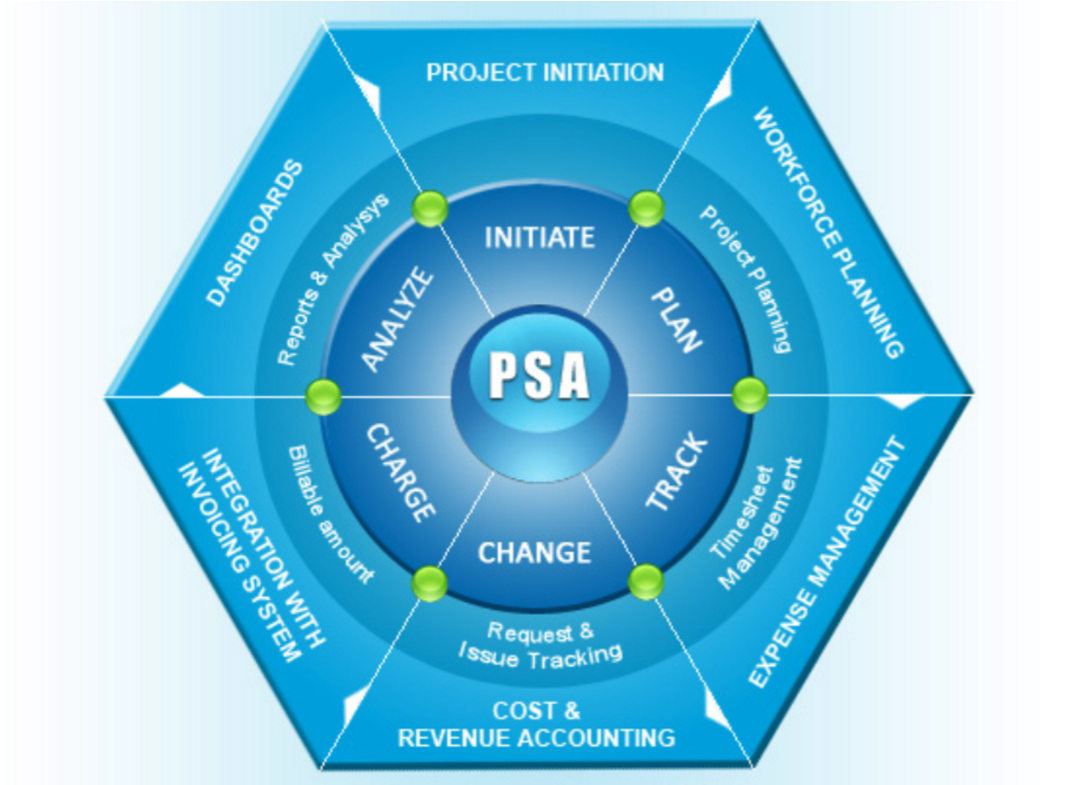Professional Services Automation (PSA)
Professional services automation (frequently abbreviated to PSA) is software designed to assist professional services firms manage client-facing activities (project management and resource management) as well as internal activities (staff utilization management, budgeting and forecasting, etc.).
PSAs can vary in functionality; however, they often include the following functions:
Core Functions:
Budget Tracking
Scheduling
Resource Management
Portfolio Management
Timekeeping
Expense Tracking
Extended Functions:
Sales Pipeline
Customer Portal
Financial Forecasting

Benefits of PSAs
Eliminate Problems Associated with Multiple Disconnected Systems – A well-designed PSA will reduce operational complexity and time inefficiencies by providing a single repository for all project data and key financial information. Professional services firms tend to adopt multiple pieces of software over time, for individual functions such as timekeeping, scheduling, support ticket tracking, etc. This results in staff needing to master several systems with disparate logins, user interfaces, workflow, data structures, etc. Complicated spreadsheets usually spring up to allow a view of data from multiple systems. This solves for the problem of having data in multiple systems, but then requires someone to update the spreadsheets manually, introducing a further productivity drain. With a PSA, users can eliminate the extra, unnecessary applications and accomplish their work in a single system. As an added bonus, there is no longer a need for special spreadsheets to stitch together application data.
Simplify Project Planning & Execution – PSA systems help users efficiently plan, manage and execute projects. Staff at all levels can quickly understand the state of their tasks and projects by utilizing reporting and dashboards within the PSA. This allows Project Managers to provide real-time updates to clients and internal management. PSAs remove the lag in reporting status and gaining access to data, allowing Project Managers and others to proactively identify and address issues, rather than report them after the fact as missed deadlines, budget overruns, etc.
How to Select the Right PSA for Your Organization
With many options available, choosing the right PSA can be challenging. Start by understanding the specific pain points you want to address in your organization. Keep in mind that a strong PSA tool should help streamline your business processes and should help your staff collaborate more effectively.
Ask these questions to help define your PSA requirements:
- What systems are currently used to manage sales opportunities, customer contacts, project artifacts, budgets, schedules, timesheets, invoices and management reports?
- What processes are tracked on spreadsheets outside the systems?
- What kinds of reports are created by stitching together data from different systems, and how much time is spent creating and updating these?
- Does your accounting/finance team have to extract data out of a timekeeping system in order to create invoices?
- Is there a system for staff to report on task statuses, or are task status updates managed primarily by emails between staff?
- Can your Project Managers create status reports for clients without first asking for status updates from team members and “scrubbing” the reported hours in order to create a budget update?
Why BusinessTime?
Once you have a clear vision of your requirements, it’s time to start evaluating PSAs and narrowing the list. Is BusinessTime the right PSA for your organization? We are committed to transparency in features and pricing, and want you to make a well-informed decision. To learn more, request a free demo today. A test-drive or trial is a great way to understand whether a PSA will be a good fit for your organization.
We also invite you to check back each week for a six-week series of PSA’s key capabilities. Next week we will focus on project management functions.


